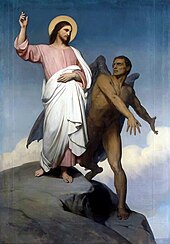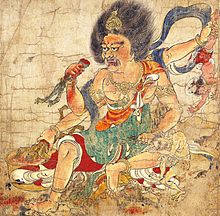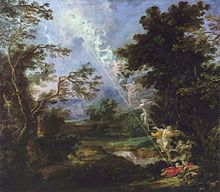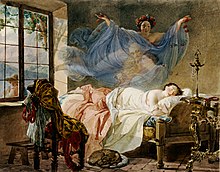One of the five paintings of Extermination of Evil portrays Sendan Kendatsuba, one of the eight guardians of Buddhist law, banishing evil.
Evil, in a general sense, is the opposite or absence of good. It can be an extremely broad concept, although in everyday usage is often used more narrowly to talk about profound wickedness. It is generally seen as taking multiple possible forms, such as the form of personal moral evil commonly associated with the word, or impersonal natural evil (as in the case of natural disasters or illnesses), and in religious thought, the form of the demonic or supernatural/eternal.
Evil can denote profound immorality, but typically not without some basis in the understanding of the human condition, where strife and suffering (cf. Hinduism) are the true roots of evil. In certain religious contexts, evil has been described as a supernatural force. Definitions of evil vary, as does the analysis of its motives. Elements that are commonly associated with personal forms of evil involve unbalanced behavior including anger, revenge, hatred, psychological trauma, expediency, selfishness, ignorance, destruction and neglect.
Evil is also sometimes perceived as the dualistic antagonistic binary opposite to good, in which good should prevail and evil should be defeated. In cultures with Buddhist spiritual influence, both good and evil are perceived as part of an antagonistic duality that itself must be overcome through achieving Nirvana. The philosophical questions regarding good and evil are subsumed into three major areas of study: meta-ethics concerning the nature of good and evil, normative ethics concerning how we ought to behave, and applied ethics
concerning particular moral issues. While the term is applied to events
and conditions without agency, the forms of evil addressed in this
article presume an evildoer or doers.
While some religions focus on good vs. evil, other religions and
philosophies deny evil's existence and usefulness in describing people.
Etymology
The modern English word evil (Old English yfel) and its cognates such as the German Übel and Dutch euvel are widely considered to come from a Proto-Germanic reconstructed form of *ubilaz, comparable to the Hittite huwapp- ultimately from the Proto-Indo-European form *wap- and suffixed zero-grade form *up-elo-. Other later Germanic forms include Middle English evel, ifel, ufel, Old Frisian evel (adjective and noun), Old Saxon ubil, Old High German ubil, and Gothic ubils.
The root meaning of the word is of obscure origin though shown to be akin to modern German Das Übel (although evil is normally translated as Das Böse) with the basic idea of transgressing.
Chinese moral philosophy
As with Buddhism, in Confucianism or Taoism there is no direct analogue to the way good and evil are opposed although reference to demonic influence is common in Chinese folk religion.
Confucianism's primary concern is with correct social relationships and
the behavior appropriate to the learned or superior man. Thus evil would correspond to wrong behavior. Still less does it map into Taoism, in spite of the centrality of dualism in that system,
but the opposite of the cardinal virtues of Taoism, compassion,
moderation, and humility can be inferred to be the analogue of evil in
it.
European philosophy
Spinoza
Benedict de Spinoza states
1. By good, I understand that which we certainly know is useful to us.
2. By evil, on the contrary, I understand that which we certainly know hinders us from possessing anything that is good.
Spinoza assumes a quasi-mathematical
style and states these further propositions which he purports to prove
or demonstrate from the above definitions in part IV of his Ethics :
- Proposition 8 "Knowledge of good or evil is nothing but affect of joy or sorrow in so far as we are conscious of it."
- Proposition 30 "Nothing can be evil through that which it possesses in common with our nature, but in so far as a thing is evil to us it is contrary to us."
- Proposition 64 "The knowledge of evil is inadequate knowledge."
- Corollary "Hence it follows that if the human mind had none but adequate ideas, it would form no notion of evil."
- Proposition 65 "According to the guidance of reason, of two things which are good, we shall follow the greater good, and of two evils, follow the less."
- Proposition 68 "If men were born free, they would form no conception of good and evil so long as they were free."
Nietzsche
Friedrich Nietzsche, in a rejection of Judeo-Christian morality, addresses this in two works Beyond Good and Evil and On the Genealogy of Morals
where he essentially says that the natural, functional non-good has
been socially transformed into the religious concept of evil by the
slave mentality of the weak and oppressed masses who resent their
masters (the strong).
Psychology
Carl Jung
Carl Jung, in his book Answer to Job and elsewhere, depicted evil as the dark side of God. People tend to believe evil is something external to them, because they project their shadow onto others. Jung interpreted the story of Jesus as an account of God facing his own shadow.
Even though the book may have had a sudden birth, its gestation
period in Jung's unconscious was long. The subject of God, and what Jung
saw as the dark side of God, was a lifelong preoccupation. An emotional
and theoretical struggle with the core nature of deity is evident in
Jung's earliest fantasies and dreams, as well as in his complex
relationships with his father (a traditional minister), his mother (who
had a strong spiritual-mystical dimension), and the Christian church
itself. Jung's account of his childhood in his quasi-autobiography,
Memories, Dreams, Reflections (New York: Vintage, 1963), provides deep,
personal background about his early religious roots– and conflicts.
Philip Zimbardo
In 2007, Philip Zimbardo suggested that people may act in evil ways as a result of a collective identity. This hypothesis, based on his previous experience from the Stanford prison experiment, was published in the book The Lucifer Effect: Understanding How Good People Turn Evil.
Religion
Problem of evil and source
Most monotheistic religions posit that the singular God is all-powerful, all-knowing, and completely good. The problem of evil
asks how the apparent contradiction of these properties and the
observed existence of evil in the world might be resolved. Scholars
have examined the question of suffering caused by and in both humans and
animals, suffering caused by nature (like storms and disease). These
religions tend to attribute the source of evil to something other than God, such as demonic beings or human disobedience.
Polytheistic and non-theistic religions do not have such an
apparent contradiction, but many seek to explain or identify the source
of evil or suffering. These include concepts of evil as a necessary
balancing or enabling force, a consequence of past deeds (karma in Indian religions), or as an illusion, possibly produced by ignorance or failure to achieve enlightenment.
Non-religious atheism generally accepts evil acts as a feature of human actions arising from intelligent brains shaped by evolution, and suffering from nature as a result of complex natural systems simply following physical laws.
Abrahamic religions
Bahá'í Faith
The Bahá'í Faith
asserts that evil is non-existent and that it is a concept reflecting
lack of good, just as cold is the state of no heat, darkness is the
state of no light, forgetfulness the lacking of memory, ignorance the
lacking of knowledge. All of these are states of lacking and have no
real existence.
Thus, evil does not exist and is relative to man. `Abdu'l-Bahá, son of the founder of the religion, in Some Answered Questions states:
"Nevertheless a doubt occurs to the mind—that is, scorpions and
serpents are poisonous. Are they good or evil, for they are existing
beings? Yes, a scorpion is evil in relation to man; a serpent is evil in
relation to man; but in relation to themselves they are not evil, for
their poison is their weapon, and by their sting they defend
themselves."
Thus, evil is more of an intellectual concept than a true
reality. Since God is good, and upon creating creation he confirmed it
by saying it is Good (Genesis 1:31) evil cannot have a true reality.
Christianity
The devil, in opposition to the will of God, represents evil and tempts Christ, the personification of the character and will of God. Ary Scheffer, 1854.
Christian theology draws its concept of evil from the Old and New Testaments. The Christian Bible exercises "the dominant influence upon ideas about God and evil in the Western world."
In the Old Testament, evil is understood to be an opposition to God as
well as something unsuitable or inferior such as the leader of the fallen angels Satan In the New Testament the Greek word poneros is used to indicate unsuitability, while kakos is used to refer to opposition to God in the human realm. Officially, the Catholic Church extracts its understanding of evil from its canonical antiquity and the Dominican theologian, Thomas Aquinas, who in Summa Theologica defines evil as the absence or privation of good. French-American theologian Henri Blocher
describes evil, when viewed as a theological concept, as an
"unjustifiable reality. In common parlance, evil is 'something' that
occurs in the experience that ought not to be."
In Mormonism, mortal life is viewed as a test of faith, where one's choices are central to the Plan of Salvation. See Agency (LDS Church).
Evil is that which keeps one from discovering the nature of God. It is
believed that one must choose not to be evil to return to God.
Christian Science
believes that evil arises from a misunderstanding of the goodness of
nature, which is understood as being inherently perfect if viewed from
the correct (spiritual) perspective. Misunderstanding God's reality
leads to incorrect choices, which are termed evil. This has led to the
rejection of any separate power being the source of evil, or of God as
being the source of evil; instead, the appearance of evil is the result
of a mistaken concept of good. Christian Scientists argue that even the
most evil person does not pursue evil for its own sake, but from
the mistaken viewpoint that he or she will achieve some kind of good
thereby.
Islam
There is no concept of absolute evil in Islam, as a fundamental universal principle that is independent from and equal with good in a dualistic sense. Although the Quran mentions the biblical forbidden tree, it never refers to it as the 'tree of knowledge of good and evil'. Within Islam, it is considered essential to believe that all comes from God, whether it is perceived as good or bad by individuals; and things that are perceived as evil or bad
are either natural events (natural disasters or illnesses) or caused by
humanity's free will. Much more the behavior of beings with free will,
then they disobey God's orders, harming others or putting themselves
over God or others, is considered to be evil.
Evil doesn't necessarily refer to evil as an ontological or moral
category, but often to harm or as the intention and consequence of an
action, but also to unlawfull actions.
Unproductive actions or those who do not produce benefits are also thought of as evil.
A typical understanding of evil is reflected by Al-Ash`ari founder of Asharism.
Accordingly, qualifying something as evil depends on the circumstances
of the observer. An event or an action itself is neutral, but it
receives its qualification by God. Since God is omnipotent and nothing
can exist outside of God's power, God's will determine, whether or not
something is evil.
Judaism
In Judaism, evil is not real, it is per se
not part of God's creation, but comes into existence through man's bad
actions. Human beings are responsible for their choices, and so have the
free will to choose good (life in olam haba) or bad (death in heaven). (Deuteronomy 28:20) Judaism stresses obedience to God's 613 commandments of the Written Torah (see also Tanakh) and the collective body of Jewish religious laws expounded in the Oral Torah and Shulchan Aruch (see also Mishnah and the Talmud). In Judaism, there is no prejudice in one's becoming good or evil at the time of birth, since full responsibility comes with Bar and Bat Mitzvah, when Jewish boys become 13, and girls become 12 years old.
Ancient Egyptian Religion
Evil in the religion of ancient Egypt is known as Isfet, "disorder/violence". It is the opposite of Maat, "order", and embodied by the serpent god Apep, who routinely attempts to kill the sun god Ra
and is stopped by nearly every other deity. Isfet is not a primordial
force, but the consequence of free will and an individual's struggle
against the non-existence embodied by Apep, as evidenced by the fact
that it was born from Ra's umbilical cord instead of being recorded in
the religion's creation myths.
Indian religions
Buddhism
Extermination of Evil, The God of Heavenly Punishment, from the Chinese tradition of yin and yang. Late Heian period (12th-century Japan)
The primal duality in Buddhism is between suffering and enlightenment, so the good vs. evil splitting has no direct analogue in it. One may infer from the general teachings of the Buddha that the catalogued causes of suffering are what correspond in this belief system to 'evil'.
Practically this can refer to 1) the three selfish
emotions—desire, hate and delusion; and 2) to their expression in
physical and verbal actions. See ten unvirtuous actions in Buddhism. Specifically, evil
means whatever harms or obstructs the causes for happiness in this
life, a better rebirth, liberation from samsara, and the true and
complete enlightenment of a buddha (samyaksambodhi).
"What is evil? Killing is evil, lying is evil, slandering is
evil, abuse is evil, gossip is evil: envy is evil, hatred is evil, to
cling to false doctrine is evil; all these things are evil. And what is
the root of evil? Desire is the root of evil, illusion is the root of
evil." Gautama Siddhartha, the founder of Buddhism, 563–483 BC.
Hinduism
In Hinduism, the concept of Dharma or righteousness clearly divides the world into good and evil, and clearly explains that wars have to be waged sometimes to establish and protect Dharma, this war is called Dharmayuddha. This division of good and evil is of major importance in both the Hindu epics of Ramayana and Mahabharata. The main emphasis in Hinduism is on bad action, rather than bad people. The Hindu holy text, the Bhagavad Gita, speaks of the balance of good and evil. When this balance goes off, divine incarnations come to help to restore this balance.
Sikhism
In
adherence to the core principle of spiritual evolution, the Sikh idea of
evil changes depending on one's position on the path to liberation. At
the beginning stages of spiritual growth, good and evil may seem neatly
separated. Once one's spirit evolves to the point where it sees most
clearly, the idea of evil vanishes and the truth is revealed. In his
writings Guru Arjan
explains that, because God is the source of all things, what we believe
to be evil must too come from God. And because God is ultimately a
source of absolute good, nothing truly evil can originate from God.
Nevertheless, Sikhism, like many other religions, does
incorporate a list of "vices" from which suffering, corruption, and
abject negativity arise. These are known as the Five Thieves, called such due to their propensity to cloud the mind and lead one astray from the prosecution of righteous action. These are:
One who gives in to the temptations of the Five Thieves is known as "Manmukh", or someone who lives selfishly and without virtue. Inversely, the "Gurmukh,
who thrive in their reverence toward divine knowledge, rise above vice
via the practice of the high virtues of Sikhism. These are:
- Sewa, or selfless service to others.
- Nam Simran, or meditation upon the divine name.
Zoroastrianism
In the originally Persian religion of Zoroastrianism, the world is a battleground between the god Ahura Mazda (also called Ormazd) and the malignant spirit Angra Mainyu (also called Ahriman). The final resolution of the struggle between good and evil was supposed to occur on a day of Judgement,
in which all beings that have lived will be led across a bridge of
fire, and those who are evil will be cast down forever. In Afghan
belief, angels and saints are beings sent to help us achieve the path towards goodness.
Question of a universal definition
A
fundamental question is whether there is a universal, transcendent
definition of evil, or whether evil is determined by one's social or
cultural background. C. S. Lewis, in The Abolition of Man, maintained that there are certain acts that are universally considered evil, such as rape and murder.
The numerous instances in which rape or murder is morally affected by
social context call this into question. Up until the mid-19th century,
the United States—along with many other countries—practiced forms of slavery.
As is often the case, those transgressing moral boundaries stood to
profit from that exercise. Arguably, slavery has always been the same
and objectively evil, but men with a motivation to transgress will
justify that action.
Adolf Hitler is sometimes used as a modern symbol of evil. Hitler's policies and orders resulted in the deaths of about 40 million people.
The Nazis, during World War II, considered genocide to be acceptable, as did the Hutu Interahamwe in the Rwandan genocide.
One might point out, though, that the actual perpetrators of those
atrocities probably avoided calling their actions genocide, since the
objective meaning of any act accurately described by that word is to
wrongfully kill a selected group of people, which is an action that at
least their victims will understand to be evil. Universalists consider
evil independent of culture, and wholly related to acts or intents.
Thus, while the ideological leaders of Nazism and the Hutu Interhamwe
accepted (and considered it moral) to commit genocide, the belief in
genocide as fundamentally or universally evil holds that
those who instigated this genocide are actually evil. Hitler considered
it a moral duty to destroy Jews because he saw them as the root of all
of Germany's ills and the violence associated with communism. Osama bin Laden
saw Islam as under attack by Western and US influence, accusing the US
and Israel of forming a Crusader-Zionist alliance to destroy Islam, and
considering US troops in Saudi Arabia infidels in the land of Islam's
two holiest sites. He therefore considered non-Muslims and Shiite
Muslims evil people intent on destroying Islamic purity and therefore
heretic.
Given his mixed record of efforts to give the Cuban people
free-of-charge healthcare and education as well as opposing US hegemony
in Latin America, while crushing all opposition and wrecking the Cuban
economy, Fidel Castro saw himself as a Caribbean Robin Hood who considered the US and capitalism evil, while anti-Castro Cuban Americans,
Cuban dissidents, and other anti-communists saw Castro as the
personification of evil in late 20th-century Cuban and Latin American
history, viewing his Castroist ideology as just as evil as any other
form of communism and bashing him for locking up dissidents and killing
innocents by firing squads, while creating mayhem in the developing
world by working to foment violent communist revolutions in the Americas
and many African countries.
Philosophical questions
Approaches
Views on the nature of evil belong to the branch of philosophy known as ethics—which in modern philosophy is subsumed into three major areas of study:
- Meta-ethics, that seeks to understand the nature of ethical properties, statements, attitudes, and judgments.
- Normative ethics, investigates the set of questions that arise when considering how one ought to act, morally speaking.
- Applied ethics, concerned with the analysis of particular moral issues in private and public life.
Usefulness as a term
One school of thought that holds that no person is evil and that only acts may be properly considered evil. Psychologist and mediator Marshall Rosenberg claims that the root of violence is the very concept of evil or badness.
When we label someone as bad or evil, Rosenberg claims, it invokes the
desire to punish or inflict pain. It also makes it easy for us to turn
off our feelings towards the person we are harming. He cites the use of
language in Nazi Germany as being a key to how the German people were
able to do things to other human beings that they normally would not do.
He links the concept of evil to our judicial system, which seeks to
create justice via punishment—punitive justice—punishing acts that are seen as bad or wrong. He contrasts this approach with what he found in cultures where the idea of evil was non-existent. In such cultures
when someone harms another person, they are believed to be out of
harmony with themselves and their community, are seen as sick or ill and
measures are taken to restore them to a sense of harmonious relations
with themselves and others.
Psychologist Albert Ellis agrees, in his school of psychology called Rational Emotive Behavioral Therapy,
or REBT. He says the root of anger, and the desire to harm someone, is
almost always related to variations of implicit or explicit
philosophical beliefs about other human beings. He further claims that
without holding variants of those covert or overt belief and
assumptions, the tendency to resort to violence in most cases is less
likely.
American psychiatrist M. Scott Peck on the other hand, describes evil as militant ignorance. The original Judeo-Christian concept of sin is as a process that leads one to miss the mark
and not achieve perfection. Peck argues that while most people are
conscious of this at least on some level, those that are evil actively
and militantly refuse this consciousness. Peck describes evil as a
malignant type of self-righteousness which results in a projection of
evil onto selected specific innocent victims (often children or other
people in relatively powerless positions). Peck considers those he calls
evil to be attempting to escape and hide from their own conscience
(through self-deception) and views this as being quite distinct from the
apparent absence of conscience evident in sociopaths.
According to Peck, an evil person:
- Is consistently self-deceiving, with the intent of avoiding guilt and maintaining a self-image of perfection
- Deceives others as a consequence of their own self-deception
- Psychologically projects his or her evils and sins onto very specific targets, scapegoating those targets while treating everyone else normally ("their insensitivity toward him was selective")
- Commonly hates with the pretense of love, for the purposes of self-deception as much as the deception of others
- Abuses political or emotional power ("the imposition of one's will upon others by overt or covert coercion")
- Maintains a high level of respectability and lies incessantly in order to do so
- Is consistent with his or her sins. Evil people are defined not so much by the magnitude of their sins, but by their consistency (of destructiveness)
- Is unable to think from the viewpoint of their victim
- Has a covert intolerance to criticism and other forms of narcissistic injury
He also considers certain institutions may be evil, as his discussion of the My Lai Massacre and its attempted coverup illustrate. By this definition, acts of criminal and state terrorism would also be considered evil.
Necessity
Martin Luther believed that occasional minor evil could have a positive effect
Martin Luther
argued that there are cases where a little evil is a positive good. He
wrote, "Seek out the society of your boon companions, drink, play, talk
bawdy, and amuse yourself. One must sometimes commit a sin out of hate
and contempt for the Devil, so as not to give him the chance to make one scrupulous over mere nothings ... "
According to the "realist" schools of political philosophy,
leaders should be indifferent to good or evil, taking actions based only
upon advantage; this approach to politics was put forth most famously
by Niccolò Machiavelli, a 16th-century Florentine writer who advised tyrants that "it is far safer to be feared than loved."
The international relations theories of realism and neorealism, sometimes called realpolitik advise politicians to explicitly ban absolute moral and ethical
considerations from international politics, and to focus on
self-interest, political survival, and power politics, which they hold
to be more accurate in explaining a world they view as explicitly amoral
and dangerous. Political realists usually justify their perspectives by
stating that morals and politics should be separated as two unrelated
things, as exerting authority often involves doing something not moral.
Machiavelli wrote: "there will be traits considered good that, if
followed, will lead to ruin, while other traits, considered vices which
if practiced achieve security and well being for the prince."
Anton LaVey, founder of the Church of Satan,
was a materialist and claimed that evil is actually good. He was
responding to the common practice of describing sexuality or disbelief
as evil, and his claim was that when the word evil is used to
describe the natural pleasures and instincts of men and women or the
skepticism of an inquiring mind, the things called and feared as evil
are really non-evil and in fact good.




















